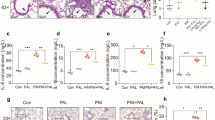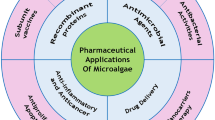Abstract
The marine environment has been represented as the most vital source of bioactive constituents. In the present work, we intended to purification, characterization, and investigation of the apoptotic effect of the bioactive molecule from edible mollusc Donax variabilis on NSCLC cell lines. The bioactive molecules were purified using Anion Exchange Chromatographic method with different millimolar of NaCl concentrations. The fractions were further performed to check the proliferative effect on A549 and NCI-H23 cells by MTT assay. The molecular mass of the active purified protein fraction (PPF-V) was 40 kDa, determined by SDS-PAGE. Furthermore, MALDI-TOF/MS was disclosed that it shared a 91% protein sequence similarity with FMRFamide peptide. Meanwhile, the apoptotic effect of PPF-V on A549 and NCI-H23 cells were investigated. Immunoblot analysis found that the PPF-V treatment groups showed the upregulation of Bax, Cytochrome-c, Cleaved Caspase-9 and 3 expression and downregulation of Bcl-2 protein expression on both NSCLC cell lines. In addition, purified protein fraction induced the loss of mitochondrial membrane potential and generation of reactive oxygen species (ROS) on lung cancer cells. Altogether, our results proved that the PPF-V from Donax variabilis inducing apoptosis against NSCLC cell lines, which could be a potential natural candidate for lung cancer therapy.





Similar content being viewed by others
References
Agrawal S, Adholeya A, Deshmukh SK (2016) The pharmacological potential of non-ribosomal peptides from marine sponge and tunicates. Front Pharmacol 7:333
Ahmad TB, Liu L, Kotiw M, Benkendorff K (2018) Review of anti-inflammatory, immune-modulatory and wound healing properties of molluscs. J Ethnopharmacol 10(210):156–178
Boice A, Bouchier-Hayes L (2020) Targeting apoptotic caspases in cancer. Biochim Biophys Acta (BBA). https://doi.org/10.1016/j.bbamcr.2020.118688
Campbell KJ, Tait SW (2018) Targeting BCL-2 regulated apoptosis in cancer. Open Biol 8(5):180002
Chen L, Zeng Y, Zhou SF (2018) Role of apoptosis in cancer resistance to chemotherapy. Current understanding of apoptosis - Programmed cell death, Yusuf Tutar, IntechOpen. https://doi.org/10.5772/intechopen.80056
Chen DW, Su J, Liu XL, Yan DM, Lin Y, Jiang WM, Chen XH (2012) Amino acid profiles of bivalve mollusks from Beibu Gulf, China. J Aquat Food Prod Technol 21(4):369–379
Cheng-Hua L, Jian-Min Z, Lin-Sheng S (2009) A review of advances in research on marine molluscan antimicrobial peptides and their potential application in aquaculture. Molluscan Res 29(1):17
Cheung RC, Ng TB, Wong JH (2015) Marine peptides: bioactivities and applications. Mar Drugs 13(7):4006–4043
Ciavatta ML, Lefranc F, Carbone M, Mollo E, Gavagnin M, Betancourt T, Dasari R, Kornienko A, Kiss R (2017) Marine mollusk-derived agents with antiproliferative activity as promising anticancer agents to overcome chemotherapy resistance. Med Res Rev 37(4):702–801
Cragg GM, Pezzuto JM (2016) Natural products as a vital source for the discovery of cancer chemotherapeutic and chemopreventive agents. Med Princ Pract 25(Suppl. 2):41–59
Dang VT, Benkendorff K, Green T, Speck P (2015) Marine snails and slugs: a great place to look for antiviral drugs. J Virol 89(16):8114–8118
Duma N, Santana-Davila R, Molina JR (2019) Non-small cell lung cancer: epidemiology, screening, diagnosis, and treatment. Mayo Clin Proc 94(8):1623–1640
Fahmy SR, Soliman AM (2013) In vitro antioxidant, analgesic and cytotoxic activities of Sepia officinalis ink and Coelatura aegyptiaca extracts. Afr J Pharm Pharmacol 7(22):1512–1522
King J (1965) The dehydrogenase of oxidoreductase lactate dehydrogenase. In: King JC (ed) Practical clinical enzymology. van D Wostrand Company, London, pp 83–93
Fernando IS, Nah JW, Jeon YJ (2016) Potential anti-inflammatory natural products from marine algae. Environ Toxicol Pharmacol 48:22–30
Follin-Arbelet V, Hofgaard PO, Hauglin H, Naderi S, Sundan A, Blomhoff R, Bogen B, Blomhoff HK (2011) Cyclic AMP induces apoptosis in multiple myeloma cells and inhibits tumor development in a mouse myeloma model. BMC Cancer 11(1):301
Gilmore A, King L (2019) Emerging approaches to target mitochondrial apoptosis in cancer cells. F1000 Res. https://doi.org/10.12688/f1000research.18872.1
Huang CY, Ju DT, Chang CF, Reddy PM, Velmurugan BK (2017) A review on the effects of current chemotherapy drugs and natural agents in treating non-small cell lung cancer. Biomedicine 7(4):23
Huseby S, Gausdal G, Keen TJ, Kjaerland E, Krakstad C, Myhren L, Brønstad K, Kunick C, Schwede F, Genieser HG, Kleppe R (2011) Cyclic AMP induces IPC leukemia cell apoptosis via CRE-and CDK-dependent Bim transcription. Cell Death Dis 2(12):e237
Kehinde OA, Mariam YA, Adebimpe OO, Blessing AA (2015) Traditional utilization and biochemical composition of six mollusc shells in Nigeria. Rev Biol Trop 63(2):459–464
Kim EJ, Juhnn YS (2015) Cyclic AMP signaling reduces sirtuin 6 expression in non-small cell lung cancer cells by promoting ubiquitin-proteasomal degradation via inhibition of the Raf-MEK-ERK (Raf/mitogen-activated extracellular signal-regulated kinase/extracellular signal-regulated kinase) pathway. J Biol Chemi 290(15):9604–9613
Kim SK, Wijesekara I (2010) Development and biological activities of marine-derived bioactive peptides: a review. J Funct Foods 2(1):1–9
Latire T, Legendre F, Bigot N, Carduner L, Kellouche S, Bouyoucef M, Carreiras F, Marin F, Lebel JM, Galéra P, Serpentini A (2014) Shell extracts from the marine bivalve Pecten maximus regulate the synthesis of extracellular matrix in primary cultured human skin fibroblasts. PLoS ONE 9(6):e99931
Lee JS, Shih PY, Schaedel ON, Quintero-Cadena P, Rogers AK, Sternberg PW (2017) FMRFamide-like peptides expand the behavioral repertoire of a densely connected nervous system. Proc Natl Acad Sci USA 114(50):E10726–E10735
Lopez J, Tait SW (2015) Mitochondrial apoptosis: killing cancer using the enemy within. Br J Cancer 112(6):957–962
López-Vera E, Aguilar MB, de la Cotera EP (2008) FMRFamide and related peptides in the phylum mollusca. Peptides 29(2):310–317
McIlwain DR, Berger T, Mak TW (2013) Caspase functions in cell death and disease. Cold Spring Harb Perspect Biol 7(4):a008656
Peymen K, Watteyne J, Frooninckx L, Schoofs L, Beets I (2014) The FMRFamide-like peptide family in nematodes. Front Endocrinol 5:90
Plaza A, Bifulco G, Keffer JL, Lloyd JR, Baker HL, Bewley CA (2009) Celebesides A−C and theopapuamides B−D, depsipeptides from an Indonesian sponge that inhibit HIV-1 entry. J Org Chem 74(2):504–512
Roufayel R (2016) Regulation of stressed-induced cell death by the Bcl-2 family of apoptotic proteins. Mol Membr Biol 33(6–8):89–99
Ruiz-Torres V, Encinar JA, Herranz-López M, Pérez-Sánchez A, Galiano V, Barrajón-Catalán E, Micol V (2017) An updated review on marine anticancer compounds: the use of virtual screening for the discovery of small-molecule cancer drugs. Molecules 22(7):1037
Sahayanathan GJ, Guha S, Chinnasamy A (2018) Antiproliferative effect of crude proteins extracted from marine clam Donax variabilis on human cancer cell lines. Int J Pharm Sci Res 9:3180–3188
Sahbaz BD, Iyison NB (2018) Neuropeptides as ligands for GPCRs. Ligand, Chandraleka Saravanan and Bhaskar Biswas, IntechOpen. https://doi.org/10.5772/intechopen.73504
Senter PD, Sievers EL (2012) The discovery and development of brentuximab vedotin for use in relapsed Hodgkin lymphoma and systemic anaplastic large cell lymphoma. Nat Biotechnol 30(7):631–637
Siegel RL, Miller KD, Jemal A (2019) Cancer statistics, 2019. CA Cancer J Clin 69(1):7–34
Tabakaeva OV, Tabakaev AV, Piekoszewski W (2018) Nutritional composition and total collagen content of two commercially important edible bivalve molluscs from the Sea of Japan coast. J Food Sci Technol 55(12):4877–4886
Toolaram AP, Kuemmerer K, Schneider M (2014) Environmental risk assessment of anti-cancer drugs and their transformation products: a focus on their genotoxicity characterization-state of knowledge and short comings. Mutat Res 760:18–35
Wei X, Nieves K, Rodríguez AD (2010) Neopetrosiamine A, biologically active bis-piperidine alkaloid from the Caribbean sea sponge Neopetrosia proxima. Bioorg Med Chem Lett 20(19):5905–5908
Wilm M, Shevchenko A, Houthaeve T, Breit S, Schweigerer L, Fotsis T, Mann M (1996) Femtomole sequencing of proteins from polyacrylamide gels by nano-electrospray mass spectrometry. Nature 379(6564):466–469
Wu D, Wang X, Sun H (2018) The role of mitochondria in cellular toxicity as a potential drug target. Cell Biol Toxicol 34:87–91
Xu L, Meng W, Cao C, Wang J, Shan W, Wang Q (2015) Antibacterial and antifungal compounds from marine fungi. Mar Drugs 13(6):3479–3513
Yang H, Villani RM, Wang H, Simpson MJ, Roberts MS, Tang M, Liang X (2018) The role of cellular reactive oxygen species in cancer chemotherapy. J Exp Clin Cancer Res 37(1):266
Zatylny-Gaudin C, Favrel P (2014) Diversity of the RFamide peptide family in mollusks. Front Endocrinol 5:178
Acknowledgements
The authors wish to thank the Proteomics facility of Molecular Biophysics Unit, Indian Institute of Science, Bangalore for the MALDI-TOF/MS analysis. The authors are grateful to acknowledge the DST-PURSE Phase II program for their financial support which enabled this research study to be completed.
Author information
Authors and Affiliations
Corresponding author
Ethics declarations
Conflict of interest
The other authors declare no conflicts of interest.
Additional information
Publisher's Note
Springer Nature remains neutral with regard to jurisdictional claims in published maps and institutional affiliations.
Rights and permissions
About this article
Cite this article
Sahayanathan, G.J., Chinnasamy, A. Apoptosis-Inducing Active Protein from Marine Clam Donax variabilis on NSCLC Cells. Int J Pept Res Ther 27, 931–939 (2021). https://doi.org/10.1007/s10989-020-10139-y
Received:
Revised:
Accepted:
Published:
Issue Date:
DOI: https://doi.org/10.1007/s10989-020-10139-y




